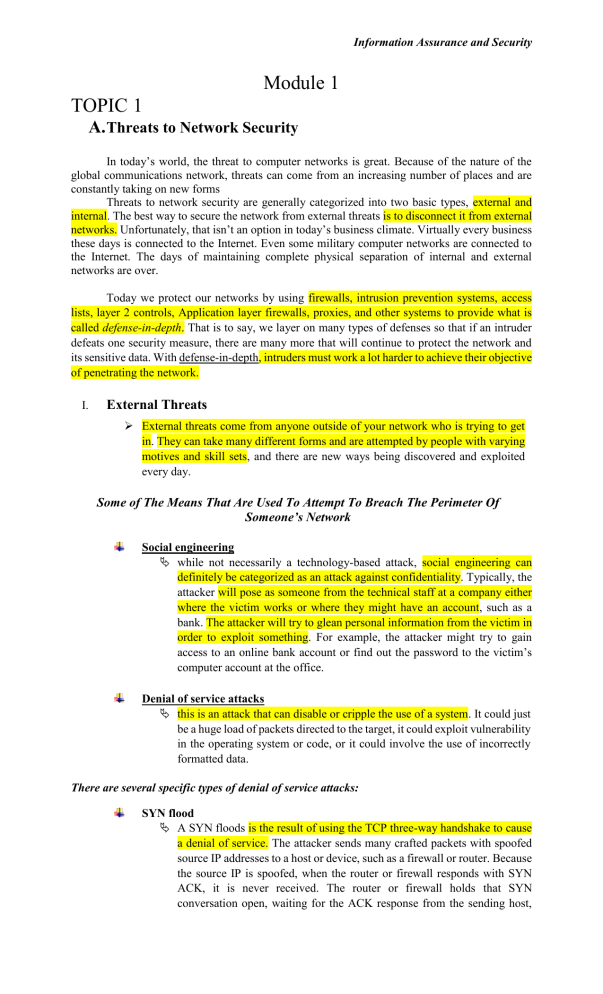Topic 1 Threats to network security (Information Assurance & security)
advertisement

Information Assurance and Security Module 1 TOPIC 1 A.Threats to Network Security In today’s world, the threat to computer networks is great. Because of the nature of the global communications network, threats can come from an increasing number of places and are constantly taking on new forms Threats to network security are generally categorized into two basic types, external and internal. The best way to secure the network from external threats is to disconnect it from external networks. Unfortunately, that isn’t an option in today’s business climate. Virtually every business these days is connected to the Internet. Even some military computer networks are connected to the Internet. The days of maintaining complete physical separation of internal and external networks are over. Today we protect our networks by using firewalls, intrusion prevention systems, access lists, layer 2 controls, Application layer firewalls, proxies, and other systems to provide what is called defense-in-depth. That is to say, we layer on many types of defenses so that if an intruder defeats one security measure, there are many more that will continue to protect the network and its sensitive data. With defense-in-depth, intruders must work a lot harder to achieve their objective of penetrating the network. I. External Threats ➢ External threats come from anyone outside of your network who is trying to get in. They can take many different forms and are attempted by people with varying motives and skill sets, and there are new ways being discovered and exploited every day. Some of The Means That Are Used To Attempt To Breach The Perimeter Of Someone’s Network Social engineering while not necessarily a technology-based attack, social engineering can definitely be categorized as an attack against confidentiality. Typically, the attacker will pose as someone from the technical staff at a company either where the victim works or where they might have an account, such as a bank. The attacker will try to glean personal information from the victim in order to exploit something. For example, the attacker might try to gain access to an online bank account or find out the password to the victim’s computer account at the office. Denial of service attacks this is an attack that can disable or cripple the use of a system. It could just be a huge load of packets directed to the target, it could exploit vulnerability in the operating system or code, or it could involve the use of incorrectly formatted data. There are several specific types of denial of service attacks: SYN flood A SYN floods is the result of using the TCP three-way handshake to cause a denial of service. The attacker sends many crafted packets with spoofed source IP addresses to a host or device, such as a firewall or router. Because the source IP is spoofed, when the router or firewall responds with SYN ACK, it is never received. The router or firewall holds that SYN conversation open, waiting for the ACK response from the sending host, Information Assurance and Security which never comes. Multiply this many time and it chews up a lot of resources, which is the intent of the attack. The attack exhausts all of the resources of the router or firewall in order to affect a denial of service. Smurf attack a single host, using a spoofed source IP, sends a ping flood to a broadcast address. What happens is that every IP that receives the ping request in that broadcast domain sends a response in an echo reply to the spoofed IP, which is a real IP and the target of the denial of service attack. This attack is well known and was a common type of attack in the ’90s. It can still be used today, but it is less common because routers can be configured to not for-ward broadcast requests through the use of the no ip directed-broadcast command. Also, hosts are generally configured to not respond to broadcasts. Distributed denial of service (DDOS) attacks Botnets are the weapon of choice in today’s world when you want to conduct a DDOS attack. Any group of computers under an attacker’s direct or indirect control can be used to launch an attack using any of the aforementioned methods. Man-in-the-middle (MITM) attack This is a classic attack in which the attackers insert themselves into the middle of a conversation where they can observe traffic that goes from one computer to another. They can simply observe or manipulate traffic as it flows from source to destination and back. Session hijacking this is similar to a man -in-the-middle attack, but the attacker is able to take over a session that the victim has launched. This is done by observing, by guessing, or by some other means of gaining access to the session ID that is in use while a victim is connected. In some cases, once the victim has been granted a session ID, the attacker assumes the role of the victim by causing a denial of service against the victim so the victim is out of the picture as far as the session goes. Then the attacker continues on with the session, posing as the victim. Brute force attack A brute force attack involves trying all possible combinations until the correct one is found. This applies to passwords, encryption keys, and the like. An example of this type of attack occurs in the wireless world. Once this is done, all traffic that is encrypted is available to the attacker, who is posing as another host on the wireless network. brute force attack; there are many others. II. Internal Threats ➢ Internal threats to a network — in which network intrusion or data theft is carried out by people inside your organization — are generally considered the most dangerous type of threat because people inside your organization have more access and more knowledge about the network and the devices on the network. ➢ could be something as simple as someone installing a key logger on a co-worker’s computer and stealing a password to a system they want access to. Internal threats have long been considered serious, but statistics are starting to show that this may not be the case. The CSI Computer Crime and Security Survey keeps track of losses attributed to computer crime and security breaches. In Figure 1.1, a graph from this study shows the loss due to insiders based on a survey size of 420 respondents. Information Assurance and Security Internal threats are successful for a number of reasons: • • • • • Improper patching Default configurations and default passwords Vendor best practices not followed Insecure programming practices Lax administration procedures Application Security Application attacks are attempts to gain control of a network or computer through a specific application, often a web browser or email application. Application attacks deserve special mention because they are said to account for 75 percent of all attacks carried out in today’s networking environment. They are frequently successful due to a number of factors: Secure Programming Practices Are Not Widespread. Programmers are usually under the gun to deliver code as quickly as possible, so security is often an afterthought. The best way to combat this is to use the Systems Development Life Cycle (SDLC) as a process to ensure that security is “built in” and not an afterthought. There’s No Firewall To Crack Through. With public facing web services, the application is already accessible. There Are A Growing Number Of Security Tools And Applications That Are Built Specifically For Web Attacks. And they are relatively easy to use. B. Network Security Objectives CIA stands for confidentiality, integrity, and availability. These are collectively known as the objectives of network security. Information Assurance and Security • Confidentiality Whether data is at rest or in motion, we are concerned about its confidentiality. Encryption is one way to protect data confidentiality. For example; when you make a purchase on the Web and you put in your credit card data, you should be concerned about the possibility of an unauthorized person seeing your personal details. That’s why you should look for the use of HTTPS and/or the little lock symbol (depending on your browser) somewhere on your browser screen to indicate a secure session. • Integrity refers to efforts made to ensure that data (whatever it may be) arrives at its destination unchanged. One method of checking integrity is to perform a check on the data using hash functions. A cryptographic hash function is defined as taking a string of variable length as input and producing a fixed length hash. These checks help determine that the data that was originally sent is the same as the data that arrived. • Availability For example, if you are unable to access you Gmail account, you have an availability problem. We have become a data-oriented society, and it’s upsetting if our data isn’t available. Table 1.1 lists the network security objectives and some of the types of attack strategy used against each. c. Classification of Data ➢ is one of the first tasks an organization needs to embrace in order to adequately protect the data. If you don’t know the value of the data that you are trying to protect, how can you know if you are assigning the appropriate controls? In many ways, it is enlightening to an organization to invest the time to determine what data they have, who owns the data, and how the data should be protected. The following lists a number of important tenets surrounding data classification: ❖ All data is not equal. ❖ Some data might be embarrassing or damaging if made public. ❖ Some compliance measures require classification. ❖ You should focus your efforts on protecting the most critical data instead of trying to protect all data equally. Roles that are played in an information security classification scheme are as follows: 1. Owner The owner of the data is ultimately the person responsible for it, and it’s usually a high-ranking member of management. The owner is generally Information Assurance and Security different than the custodian. 2. Custodian The custodian is the person who takes care of the data, usually someone within the IT department. This is the person who maintains the server, the database, the backup tape, and so on. 3. User The user is someone who uses the data as part of their day-to-day duties. Users are generally governed by policies as to what they can or can’t do with the data and how to handle it.


